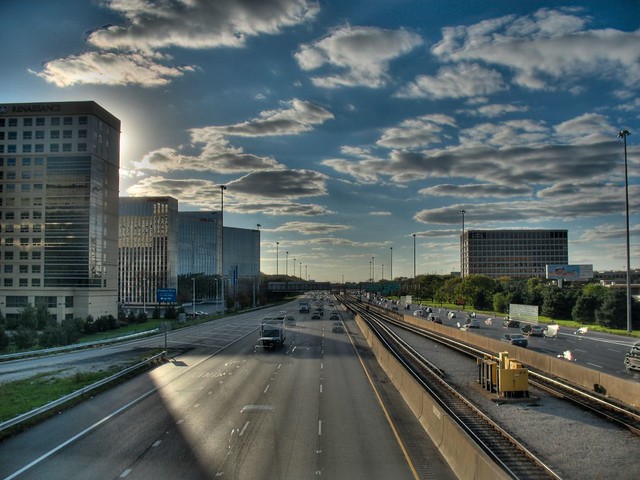The Illinois Department of Transportation is pulling another bad idea out of its old bag of tricks, proposing to add two traffic lanes on the Kennedy Expressway between Harlem Avenue and Cumberland Avenue. Also included in IDOT's proposal are modified ramps at Cumberland and a new ramp onto the Tri-State Tollway (I-294).
IDOT's stated goal is to relieve congestion and reduce crashes, but past experience shows that widening highways will just induce more traffic, while this is hardly a location where spending millions to improve safety is justified. As is typical for IDOT communications, the agency hasn't released information about the severity of crashes or explained why this stretch should be a priority for spending limited safety dollars.
The project would add a fourth lane of traffic in each direction on the Kennedy, so that drivers entering and exiting the highway don’t interrupt the traffic flow of the other three lanes. In ten years, when the fourth lane fills up with more people driving because of the road’s increased capacity, IDOT could use the same baseless rationale to add a fifth lane.
Todd Litman of the Victoria Transport Policy Institute explained this phenomenon, called "induced demand," in a 2001 paper [PDF]: "Congestion reaches a point at which it constrains further growth in peak-period trips. If road capacity increases, the number of peak-period trips also increases until congestion again limits further traffic growth."
According to IDOT's project newsletter [PDF], Harlem Avenue (at the east end of the project) "is a major traffic generator which contributes to congested conditions." But it's the destinations on Harlem that generate a demand for travel, and the options at people's disposal to reach those destinations that dictate how much car traffic will be generated.
Homes and businesses are some of the destinations that need access via Harlem. Can people easily reach these destinations via transit, or by walking or bicycling? With the Kennedy widening, it will be certainly be easier to drive, adding more car traffic to Harlem. This is turn will slow down buses and make the street less pleasant for biking and walking, in a vicious cycle that harms the most efficient modes for city transportation.
IDOT needs to drop the wasteful, 1950s-era approach and adopt modern transportation management solutions. The agency has not built a single carpool lane in the state. That wasn't even considered for the Kennedy. Nor was a bus lane, increased Blue Line or bus route capacity, improvements to Blue Line access, or any option besides making more room for the least efficient mode of all.
There's another opportunity that IDOT isn’t talking about. The Illinois Tollway Authority will be adding "managed lanes" to I-90 on the part under its jurisdiction. This managed lane would be tolled differently than the other lanes, with prices for single-occupancy cars set to ensure that the lane remains uncongested for the buses and carpool vehicles that use it (the exact operations rules haven't been established or publicized). Why doesn't IDOT manage congestion in a way that actually helps keep traffic under control, instead of spending millions on projects that increase traffic?
The final flaw in IDOT's approach is neglecting the full costs of their projects. According to DNAInfo, the construction cost will be approximately $43 million, but the total costs -- more roads to maintain, more induced traffic, and additional pollution and noise -- were not calculated. Th $43 million figure also excludes the cost of a new flyover that IDOT is planning between I-90 and Cumberland Avenue to eliminate a traffic-slowing lane change.
IDOT's purported cure for traffic is like curing obesity by loosening your belt. Transportation solutions are diverse, but IDOT's bag of tricks isn't, and the agency's single-minded focus on making room for cars means Chicagoans will have to put up with more traffic and fewer travel options.
A public meeting will be held tomorrow evening at the Holiday Inn Chicago O'Hare, from 4 p.m. to 7 p.m, at 5615 N Cumberland Avenue. The public comment period is open until February 27. Email Marie.Glynn@Illinois.gov or send a letter to Marie Glynn, P.E., IDOT District 1, 201 West Center Court, Schaumburg, IL 60196.




